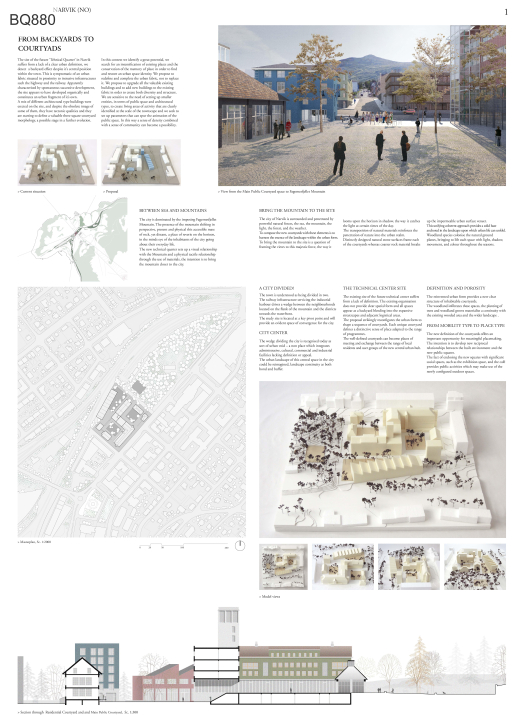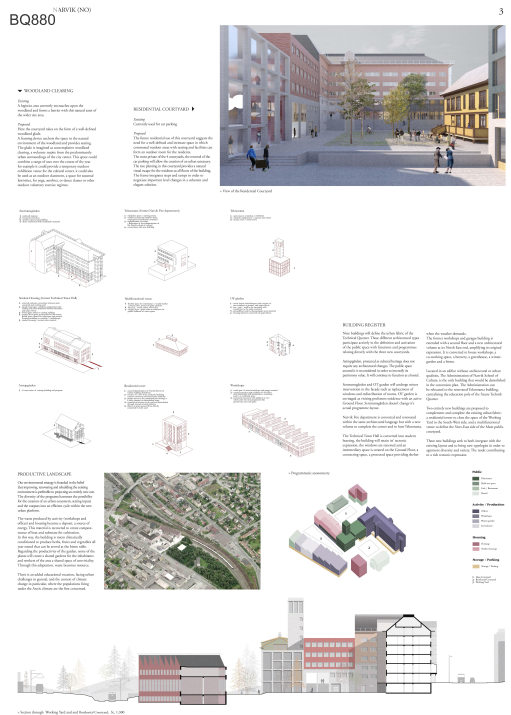Project:
From Backyards to Courtyards

About
-
The site of the future Technical Quarter in Narvik suffers from a lack of a clear urban definition, we detect a backyard effect despite its central position within the town. This is symptomatic of an urban fabric situated in proximity to intrusive infrastructures such as the highway and the railway. Apparently characterized by spontaneous successive development, the site appears to have developed organically and constitutes an urban fragment of its own. A mix of different architectural type buildings were erected on the site, and despite the obsolete image of some of them, they have tectonic qualities and they are starting to define a valuable three square-courtyard-morphology, a possible stage in a further evolution.
In this context we identify a great potential, we search for an intensification of existing places and the conservation of the memory of place in order to find and restore an urban space identity. We propose to redefine and complete the urban fabric, not to replace it. We propose to upgrade all the valuable existing buildings and to add new buildings to the existing fabric in order to create both diversity and structure. We are sensitive to the need of setting up smaller entities, in terms of public space and architectural types, to create living areas of activity that are clearly identified at the scale of the townscape and we seek to set up parameters that can spur the animation of the public space. In this way a sense of density combined with a sense of community can become a possibility.
The existing organization does not provide clear spatial form and all spaces appear as a backyard bleeding into the expansive streetscapes and adjacent logistical areas. The proposal strikingly reconfigures the urban form to shape a sequence of courtyards. Each unique courtyard defines a distinctive sense of place adapted to the range of programs. The well-defined courtyards can become places of meeting and exchange between the range of local residents and user groups of the new central urban hub.
The new definition of the courtyards offers an important opportunity for meaningful placemaking. The intention is to develop new reciprocal relationships between the built environment and the new public squares. The fact of enclosing the new squares with significant social spaces, such as the exhibition space, and the café provides public activities which may make use of the newly configured outdoor spaces.
-
The Europan theme, Productive Cities, also has a metaphorical meaning in Narvik. The prominent location in the inner city is still characterized by a mix of functions from the last decades. However, these functions do no longer meet the new requirements for a communicative city centre in which the university with its productive minds should also play a role.
The project From Backyards to courtyards follows, in some sense, comparable urban and architectural strategies to the winning project. The architects are identifying the potential of the existing buildings, searching for the intensification of existing places and the conservation of the memory of place in order to find and restore an urban space identity. With a series of additions and transformations of the existing buildings, they are nicely completing the urban fabric.
There are three types of public spaces showing each their own urban form, in which the architectural reference to the material qualities of the city plays a major role. A very beautiful idea of this project is the open a public space with view to the mountain Fagernesfjellet, giving the urban space a transversal axis. This space introduces a previously missing link that connects the core of the city better with the adjacent residential areas and the higher-lying university buildings.
On the other hand, the design proposition with its concentration of building mass to the side of the main road is a little less flexible than the first prize, and the differentiation between public and semi-public areas and connection to the park is not quite as good.
-
Team Representative: Márton Tövissi (RO) – architect
Associates: Mihai Buse (FR), Emőke Forró (RO), Boris Girin (FR) – architects; Elinor Scarth (GB), Etienne Haller (FR) – landscape architects8/b/9 strada Cintarului, 530150 Miercurea Ciuc (RO)
+40 74 25 12 346 - info@a-platz.com - a-platz.com
M Tövissi, E. Forró , M. Buse, B. Girin, E. Haller & E. Scarth
Team interview
1. How did you form the team for the competition?
Based between Edinburgh (Scotland), Paris (France) and Miercurea Ciuc (Romania), our collective is made of various profiles showing different interests and sensibilities about the question of the urban fabric. At the same time, we consider new urban forms through a set of common values that reemerge on all our propositions. The collective formed by A-Platz Architecture, MEMO Architecture and INLANDSIS Landscape Architects is activated on specific occasions from research projects to architectural competitions. Our team was noticed on different international competitions including the Blueprint Competition (2016) about the transformation of the Genoa Port Area. Our proposal has been awarded a first prize ex aequo and still remains a key project in the larger reflexion we try to develop about the essence of the city. Our collective is structured by different members acting with complete autonomy and perpetually sharing with others to rise new perspectives and solutions, to take initiatives in a non-hierarchical, dynamic and flexible manner.
2. How do you define the main issue of your project, and how did you answer on this session main topic: the place of productive activities within the city?
The site of the future 'Technical Quarter' in Narvik suffers from a lack of a clear urban definition, we detect a backyard effect despite its central position within the town. This is symptomatic of an urban fabric situated close to intrusive infrastructures such as the highway and the railway. Apparently characterized by spontaneous successive development, the site appears to have developed organically and constitutes an urban fragment of its own. A mix of different architectural type buildings were erected on the site, and despite the obsolete image of some of them, they have tectonic qualities and they are starting to define a valuable three square-courtyard morphology, a possible stage in a further evolution. In the context of a relatively small city with limited means, we propose punctual interventions on existing buildings to improve instead of removing them. At the same time, we propose additional buildings completing the existing sites configuration. Through this pragmatic approach we see a realistic way to turn the site in a short period of time to an effective place of production in the city. We understand different expectations about the program and propose to affect each part of it to the different buildings of the site according to their intrinsic qualities.
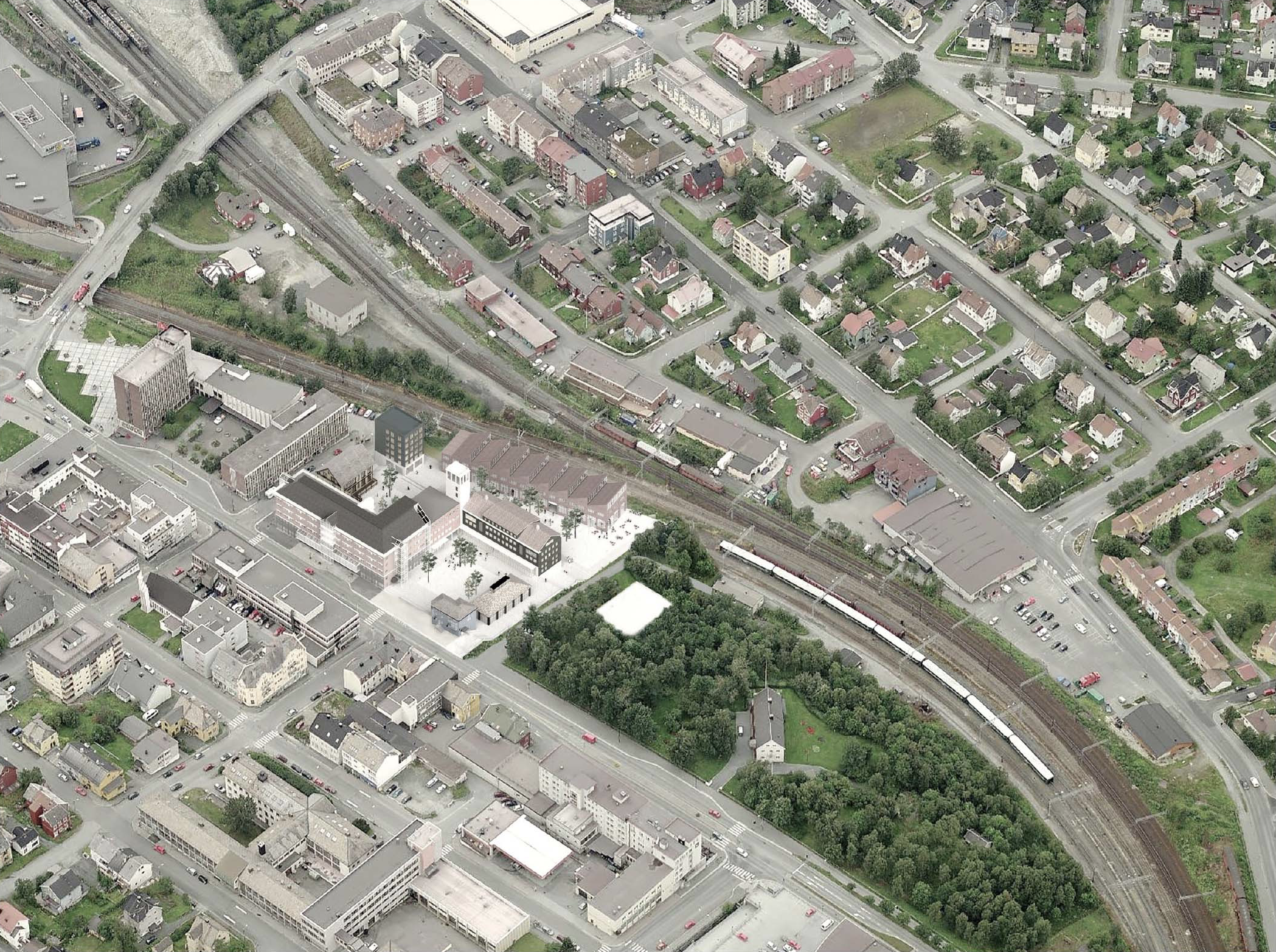
3. How did this issue and the questions raised by the site mutation meet?
We used the courtyards as tools to turn outdoor spaces into a new spot completely dedicated to production in the city. The three newly defined courtyards work together as a link between both immediate and large-scale context. Between existing streets network and the sites buildings, the courtyards play an important role of reconnection and make possible the opening of the site on a larger urban surrounding. Connected to the buildings, the courtyards are not only public spaces but also direct extension of indoor spaces where an infinity of production processes can be invented. At a larger scale we used courtyards to frame the landscape and reveal what makes Narvik's identity.

4. Have you treated this issue previously? What were the reference projects that inspired yours?
We often use analogous references supported by theoretical ones, but here the main inspiration was the site itself and its surroundings. The morphology of the Piazza San Marco in Venice and a drawing by Hans Kollhoff for 'Collage city' of Colin Rowe helped us formalizing and theorizing our approach. The analyses of Aldo Rossi in 'The Architecture of the city' influenced us as well.
5. Urban-architectural projects like the ones in Europan can only be implemented together with the actors through a negotiated process and in time. How did you consider this issue in your project?
We are very sensitive to clear and responsible choices in the conception process leading to an architectural solution that is buildable. We try as soon as possible to be pragmatic and efficient in our choices during the entire phase of conception. The project seeks to reveal the potential of the site with minimal means in an attempt to create a situation in which all the actors involved could collaborate, and share the same vision of the project.
6. Is it the first time you have been awarded a prize at Europan? How could this help you in your professional career?
This is the second time that we are awarded at Europan. This could help us building up new professional connections and hope to gain a more visibility for our work.
Related projects
-
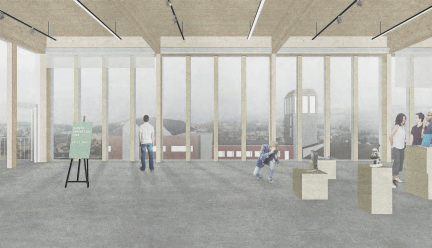
On Reflection
On Reflection is a rich and complex architectural micro-cosmos in the center of Narvik.
-
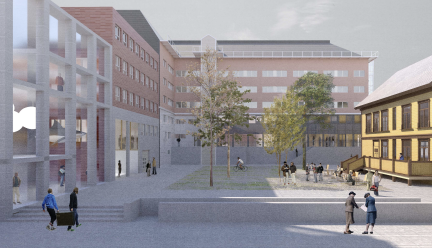
From Backyards to Courtyards
We identify a great potential, we search for an intensification of existing places and the…
-
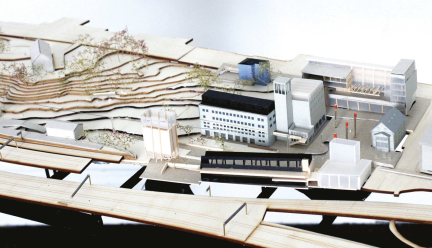
The Ecology of Making
The Ecology of making is a holistic vision for a development of the technical quarter in Narvik.
